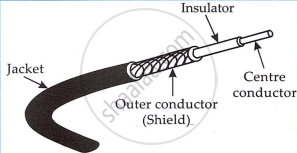Topics
Introduction to Microprocessors and Organization of 8085
Instruction Set and Programming of 8085
Introdcution to Inted X-86 Family
Introduction to Microcontroller
Networking Technology
- Introduction to Networking
- Types of Networks
- Multiplexing
- Study of Transmission media
- Coaxial cable (Cable Media)
- Twisted pair cable
- Fiber Optic Cable
- Unbounded (Wireless) Media
- Access Methods
- Network Topologies
- Ethernet (Network Architectures)
- Token-Ring (Network Architectures)
- Internet protocols
- Introduction to connectivity devices
- Construction
- Types of Coaxial Cable
- Advantages and Disadvantages of Coaxial Cable
Coaxial cable (Cable Media)
Construction
A coaxial cable is constructed with four key components. At the core is a center conductor, typically made of solid or stranded copper wire. Surrounding this is an outer conductor, often braided wires or metallic foil, which serves as a shield to protect the inner conductor from electromagnetic interference (EMI) and acts as a ground. An insulating layer separates the inner and outer conductors, ensuring even spacing between them. Finally, the entire cable is encased in a plastic jacket, providing protection from physical damage.

Types of Coaxial Cable
There are two types of coaxial cable:
i.Thinnet: Thinnet is a light, flexible, and inexpensive cabling medium, easy to install. It belongs to the RG-58 family with a 50-ohm impedance, is 0.25 inches (6 mm) thick, and can reliably transmit signals over 185 meters (610 feet).
ii. Thicknet : Thicknet is thicker than thin net. It is about 0.5 inches (13 mm) in diameter. Since it is thick, it does not bend. It is difficult to work with thicknet. It has thick center core. It can carry more signals and at a larger distance. It can transmit a signal approximately 500 meters (1650 feet).
Advantages and Disadvantages of Coaxial Cable
Advantages:
- Widely used due to availability in various sizes.
- Shielding offers strong resistance to EMI.
- Lower attenuation compared to twisted pair cables.
Disadvantages:
- More expensive than twisted pair, but cheaper than fiber optic.
- Lower bandwidth capacity than fiber optic cables.
